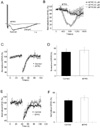ABBREVIATIONS
PF
PC
EPSC
TRPC channel
CB1R
mGluR
DSI/DSE
RER
Ca-RER
VOCC
ER
CF
Journal List > Korean J Physiol Pharmacol > v.16(2) > 1025790
PF
PC
EPSC
TRPC channel
CB1R
mGluR
DSI/DSE
RER
Ca-RER
VOCC
ER
CF
 | Fig. 1PF burst induced Endocannabinoid-mediated short-term depression in cerebellar Purkinje cell. (A) The induction protocol for transient depression and trace in induction. 10 parallel fiber stimuli were applied at 100 Hz in current clamp mode. (B) EPSPs before induction and 5 s after induction. (Top: control, bottom: 3 µM of AM251 applied, Black: before induction, Grey: 5 s after induction) (C) EPSPs were evoked by a single pulse of PF stimulus during an 80 seconds baseline and for 60 seconds after induction of transient depression. After that, 3 µM of AM251 was applied for 10 minutes, and then recording of baseline and induction of transient depression were established in the same cell. Amplitudes of EPSPs were normalized to baseline before and after application of AM251. (D) Summary bar graphs showing change of depression of EPSPs after application of AM251. |
 | Fig. 2PF burst-induced Endocannabinoid-mediated short-term depression is mGluR-dependent. (A) EPSPs before induction and 5s after induction (Top: control, bottom: 100 µM of CPCCOEt applied, Black: before induction, Grey: 5 s after induction). (B) EPSPs were evoked by a single pulse of PF stimulus during an 80 seconds baseline and for 60 seconds after induction of transient depression. After that, 100 µM of CPCCOEt was applied for 10 minutes, and then recording of baseline and induction of transient depression were established in the same cell. Amplitudes of EPSPs were normalized to baseline before and after application of CPCCOEt. (C) Summary bar graphs showing change of depression of EPSPs after application of CPCCOEt. |
 | Fig. 3TRP blocker SKF96365 inhibited PF burst-induced Endocannabinoid-mediated short-term depression. (A) EPSPs before induction and 5 s after induction (Top: control, bottom: 30 µM of SKF96365 applied, Black: before induction, Grey: 5 s after induction). (B) EPSPs were evoked by a single pulse of PF stimulus during an 80 seconds baseline and for 60 seconds after induction of transient depression. After that, 30 µM of SKF96365 was applied for 10 minutes, then recording of baseline and induction of transient depression were established in the same cell. Amplitudes of EPSPs were normalized to baseline before and after application of SKF96365. (C) Summary bar graphs showing change of depression of EPSPs after application of SKF96365. |
 | Fig. 4TRP blocker SKF96365 inhibited endocannabinoid-mediated short-term depression induced by association of PF burst and PC depolarization. (A) The induction protocol for transient depression and current trace in induction. 10 parallel fiber stimuli at 100 Hz and 50 ms of PC depolarization 50 ms after PF burst were applied in voltage clamp mode. (B) EPSCs before induction and 5 s after induction (Left: control, right: 30 µM of SKF96365 applied, Black: before induction, Grey: 5 s after induction). (C) EPSCs were evoked by a paired pulse of PF stimulus during a 40 seconds baseline and for 60 seconds after induction of transient depression. After that, 30 µM of SKF96365 was applied for 10 minutes, and then recording of baseline and induction of transient depression were established in the same cell. Amplitudes of EPSCs were normalized to baseline before and after application of SKF96365. (D) Summary bar graphs showing change of depression of EPSCs after application of SKF96365. |
 | Fig. 5Endocannabinoid-mediated short-term depression in cerebellar Purkinje cell was not inhibited by BTP2. (A) Slow current traces evoked by 10 PF stimuli at 100 Hz during 5 µM of NBQX (Black: Control, Grey: 50 µM of BTP2). (B) Slow EPSCs were evoked during a 200 seconds baseline and for 500 seconds after induction of transient depression application. After that, 50 µM of BTP2 was applied for 10 minutes, and then recording of baseline and induction of transient depression were established in the same cell. (C) EPSPs were evoked by paired pulse of PF stimulus during a 40 seconds baseline and for 60 seconds after induction of transient depression. After that, 50 µM of BTP2 was applied for 10 minutes, and then recording of baseline and induction of transient depression were established in the same cell. Amplitudes of EPSCs were normalized to baseline before and after application of BTP2. (D) Summary bar graphs showing change of depression of EPSPs after application of BTP2. (E) EPSPs were evoked by paired pulse of PF stimulus during a 40 seconds baseline and for 60 seconds after induction of transient depression. After that, 50 µM of BTP2 was applied for 10 minutes, and then recording of baseline and induction of transient depression were established in the same cell. Amplitudes of EPSCs were normalized to baseline before and after application of BTP2. (F) Summary bar graphs showing change of depression of EPSCs after application of BTP2. |
PF
PC
EPSC
TRPC channel
CB1R
mGluR
DSI/DSE
RER
Ca-RER
VOCC
ER
CF